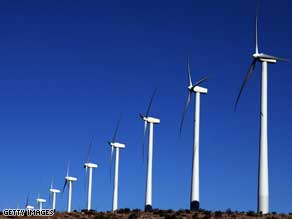The prospects for wind power could be greatly enhanced if cost-effective storage could be implemented. Some, like Minnesota based Xcel Energy, are putting their faith in new battery technology. But a UK professor, Seamus Garvey thinks he might have found another solution -- storing energy in flexible containers on the ocean floor.
Professor Garvey's idea of using Compressed Air Energy Storage (CAES) isn't a new one, but his methods are.
...Based at Nottingham University, Professor Garvey -- whose interest in wind turbines stretches back to his school days -- began his research into compressed air storage two years ago.
"I was thinking about how textile composites and textile structures might be relevant in the context of renewable energy," he told CNN.
In a moment of inspiration, Garvey realized that air could be compressed using a wind turbine or a wave-powered device.
"Drawing a mass down within the blade of the piston itself compresses the air," he said.
The prospects for his energy storage idea with tidal power are perhaps even better. "With tidal power you can use a hydraulic ram. This can take a large flow of water at a low pressure. Out of that it can then give you a small flow of water at a high pressure."

Naturally, storing vast amounts of air requires vast amounts of storage. Professor Garvey envisages a cone-like structure stretching 50 meters wide at the top to around 80 meters across at the base.
The bags are made of a combination of plastics. "A polyester reinforcement at the core with probably a polythene layer around that," Garvey said.
At a depth of around 600 meters, Professor Garvey calculates that the bags would be able to store 25 megajoules of energy for every meter cubed. The deep water is essential. "Only in deep water, where the pressure is greatest, are the bags a good economic proposition," Garvey explained.
Although there is an additional cost in fixing reinforcement cables and ballast, Garvey believes the future economic prospects for his invention are good.
See here.